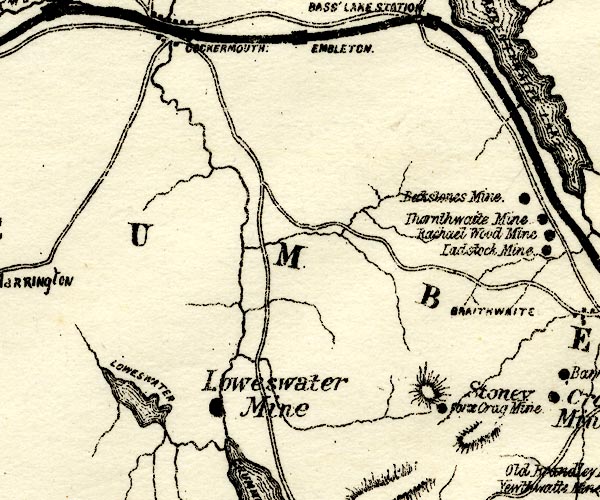




item:- geology
 goto source
goto sourcePage 154:- "... Veins of lead ore occur in several places; and have been worked between Skiddaw and Saddleback, in Thornthwaite, Newlands, and Buttermere; but one in the parish of Loweswater, and one below the level of Derwent Lake, are the most productive at present in this district."
placename:- Loweswater Mines
 goto source
goto sourcepage 106:- "LOWESWATER MINES."
"A line drawn on the map, a little to the north of west and south of east, from Stoneycroft in the Vale of Newlands, through Force Crag, to Scale Hill, in the Vale of Lorton, shows that such a line connects the mines at these three places, and other minor mine workings further west, therefore, although owing to long stretches of soil and turf, or scree covered ground, obscuring the vein and making it difficult, if not impossible to trace it all the way, there can be little doubt that all these mines are on one vein. If the line indicated is continued further to the east, from Stoneycroft across Derwentwater, it will be seen that the vein fissure of Catgill, between Walla Crag and Falcon Crag, is on the same line, and that it, too, may be regarded as a continuation of the same vein."
"The shaft of Loweswater Mine, on the western side of the river Cocker, opposite Scale Hill, was sunk about 75 or 80 years ago, to a depth of 17 or 18 fathoms, and a considerable extent of ground was excavated and a good deal of ore obtained from it. The timbers of the old workings are now decaying and a part of the surface occasionally falls in. There was a good deal of water in the mine, and a powerful water-wheel was erected to pump the water from it, also to haul the ore to the surface, and propel the dressing machinery."
"There is also another parallel vein to the south of Loweswater Valley, between Whiteoak and Highnook Becks, from which some ore was obtained about the time that Loweswater Mine was worked; and another vein still further south, on the west side of Mosedale Beck, beneath Hencombe, also yielded some ore."
placename:- Loweswater Mine

PST2NY12.jpg
"Loweswater Mine"
mine symbol
item:- JandMN : 162.2
Image © see bottom of page
